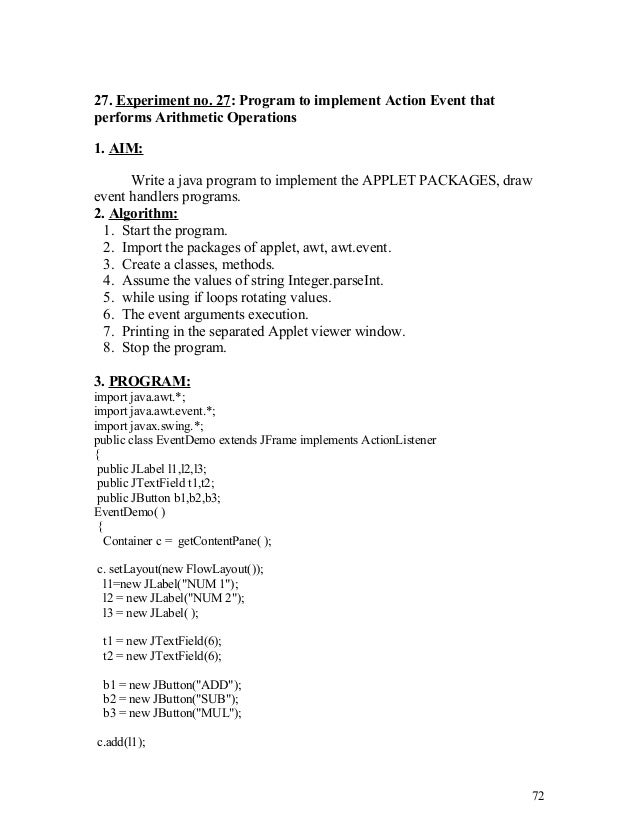Rmi Program For Arithmetic Operation In Java

The java concept RMI, stands for Remote Method Invocation made it very easy the client to access a method on server, which is known as remote method invocation. Objective: The main objective of RMI is to provide the facility of invoking method on server. This is done by creating a RMI Client and RMI Server.
Program For Arithmetic Operation In C
RMI Client invokes a method defined on the RMI Server. In this article, we will learn:. What is RMI (Remote Method Invocation)?. How do we in invoke a method running in differ JVM from another JVM. How to write an application using RMI methodology RMI Terminology: Figure 1: Method is invoked by client on the server using RMI RMI is used to communicate between two running java applications on different JVM (Java Virtual Machines). The main motive behind RMI implementation is to invoke one method running on different JVM.
The JVM Application, in which an invoked method is running out, is called RMI Server, where as the invoking application running on the different JVM is called RMI Client. Remote Obj / RMI Server: It is an object that exposes methods which can be invoked by Remote Client using RMI. RMI Client: It is an object that invokes remote methods on an RMI Server. Stub: A stub is proxy that stands for RMI Server on client side and handles remote method invocation on behalf of RMI Client. Skeleton: It is a proxy that stands for RMI client on server side and handles remote method invocation on RMI Server on behalf of client.
Registry Service: A Registry Service is an application that provides the facility of registration & lookup of Remote stub. A Registry Service provides location transparency of Remote Object to RMI Client. Steps: Define a Remote Interface that contains methods which can be remotely invoked on remote object. Each Remote Interface have to extend java.rmi.Remote Interface and each remote method declared in the remote interface have to throw java.rmi.RemoteException.
Lisiting 1: Define Remote Interface, declaring Remote Method. Javac HelloInterface.java Hello.java rmic Hello Start Registry Services using rmiRegistry tool: rmiRegistry or rmiRegistry Create an object of RMI server and register its stub in the RMI registry. Java.rmi.Naming class provide static method for registration in the lookup of rmiStub.
Bind: This method is used to register a remote object (stub of object) in the rmiRegistry. Syntax: public static void bind(String name, Remote object) throws RemoteException, AlreadyBindException rebin: This method is used to rebind the remote object in the rmiRegistry. Syntax: Public static void rebind(String name, Remote object) throws RemoteException Lookup: This method is used to lookup remote stub in the rmiRegsitry. Syntax: Public static Remote lookup(String name) throws RemoteException Listing 4: Define a RMI Server Class.
To have full access to this post (or download the associated files) you must have. See the prices for this post in Mr.Bool Credits System below: Individually – in this case the price for this post is US$ 0,00 in this case you will buy only this video by paying the full price with no discount. Package of 10 credits - in this case the price for this post is US$ 0,00 This subscription is ideal if you want to download few videos. In this plan you will receive a discount of 50% in each video. Package of 50 credits – in this case the price for this post is US$ 0,00 This subscription is ideal if you want to download several videos. In this plan you will receive a discount of 83% in each video.
Writing Arithmetic In Java
- This tutorial explains Java arithmetic operators by simple examples. Java arithmetic operators perform addition, subtraction, multiplication, division, and modulo.
- Java program which performs basic arithmetic operations addition, subtraction, multiplication and division.
Airthematic Operation in Java RMI Add Two Number Java RMI Program To write a program for addition of two numbers using RMI. EJB And Java RMI program.
For the static classes, I did not say that I was not enclosing them into another class. I made these static simply because I was instanciating them from a static function but you're right, it would have been simpler to just remove this word everywhere. As to your other statement, 'Regarding the scenario in the question, there is no meaning to use a generic class in this way', I'm not totally sure to understand what you are saying but lets me just say that's simply impossible in Java to solve the original scenario exactly as described. Flash player mac os 10.12.
– Dec 27 '12 at 1:03.